Easy Duck Confit

Scott Heimendinger
August 27, 2021
Duck confit is simple when made with the Anova Precision Cooker. And if you choose to vacuum-seal the legs before cooking, you can substantially reduce the amount of duck fat needed to confit the meat. Sealing also ensures that the fat, juices, and flavor they release will stay in the bag, rather than waft into the air. (You can, of course, choose to submerge the duck legs in fat in a baking dish instead; use the smallest dish in which you can fit the legs in order to reduce the amount of fat needed.)
Notes: This recipe uses 100% humidity to cook the bagged confit in order to speed up cooking.
You can confit the duck ahead of time. If you’d like to store for later, transfer the sealed bags of the confit duck to an ice bath after cooking sous vide. Transfer (unopened) to the refrigerator and refrigerate for up to 1 month. When ready to eat, return the duck (still in the bag) to the oven and cook for 30 minutes using the same sous vide settings as before. Continue with the recipe at step 9.
Serves
2
Prep Time
24:30
Cook Time
06:15

5 (2)
1318
Ingredients
4 tsp
Diamond Crystal kosher salt
5 cloves
garlic, peeled
5 sprigs
fresh thyme
1 Tbsp
juniper berries (optional)
2 tsp
black peppercorns
2 whole
duck legs
¼ cup
rendered duck fat or butter
Steps
1. Combine Salt and Aromatics
Combine salt, garlic, thyme, juniper berries, and black peppercorns in a mortar and pestle or small food processor.

2. Pulverize
Pulverize the mixture and grind together until it forms the consistency of wet sand. This mixture is the cure for the duck and will be rinsed away in a later step.
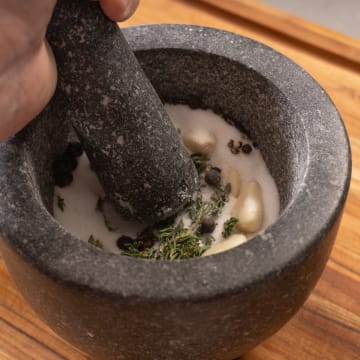
3. Rub Duck with Cure
Coat the underside of the legs thoroughly with the salt mixture. Place the legs skin-side-up on a small sheet pan and rub the remaining cure into the skin, coating it completely.
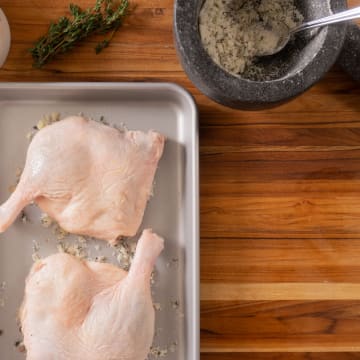
4. Refrigerate
Cover the meat with plastic wrap and refrigerate for at least 8 hours or up to 24 hours.
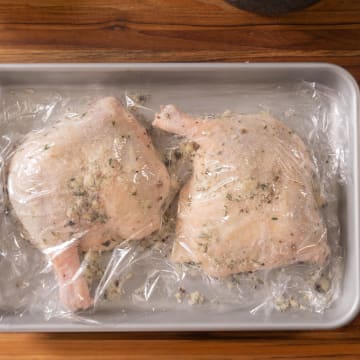
5. Preheat Oven
Rack
Sous Vide Mode: On
Steam: 100%
Temp: 179.6°F
Heat: Rear, Top
6. Rinse and Dry Duck
Thoroughly rinse the legs with cold water and pat dry with paper towels.
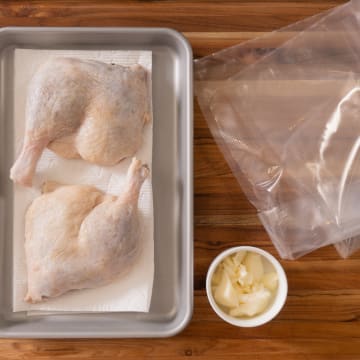
7. Seal with Fat
Vacuum seal the legs with 2 tablespoons of duck fat per leg (see note). You may seal the legs together into a single bag, but ensure there’s enough room that they don’t touch.

8. Slow Cook
Rack
Cook until the skin renders out its fat and the meat turns fall-off-the-bone tender, 6 hours. Remove from the oven and chill if desired (see note).
Sous Vide Mode: On
Steam: 100%
Temp: 179.6°F
Heat: Rear, Top
06:00 Timer
9. Adjust Oven for Roasting
Rack
When ready to cook, heat the oven for roasting.
Sous Vide Mode: Off
Steam: Off
Temp: 482°F
Heat: Top, Rear
10. Decant Liquid
Open the bags and decant the liquid into a small pitcher. The liquid will be a mixture of flavorful juices and rendered fat. Allow it to settle and separate, reserving about 1 tablespoon of the rendered fat.
11. Pat Dry
Pat the duck legs as dry as possible. Place on a greased, foil-lined sheet pan.

12. Roast
Rack
Return to the oven and cook until the skin has browned and crisped, 8 to 12 minutes.
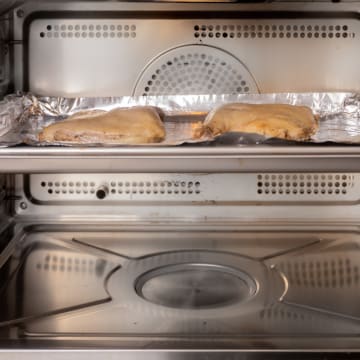
Sous Vide Mode: Off
Steam: Off
Temp: 482°F
Heat: Top, Rear
00:08 Timer
13. Remove and Plate
Remove from the oven and transfer to a serving plate.
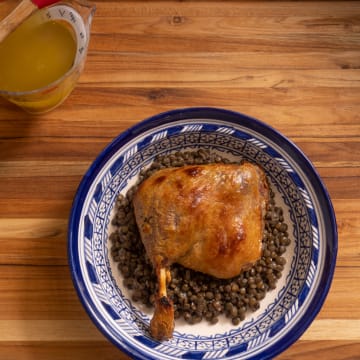
14. Brush and Serve
Brush the skin of each leg with a little of the reserved fat. Serve immediately.

© 2013 - 2026 Anova Applied Electronics, Inc.